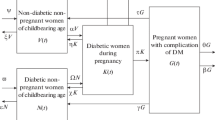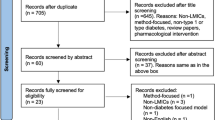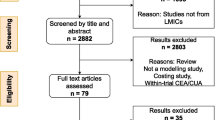Abstract
Diabetes in pregnancy (DIP) is an increasing public health priority in the Australian Capital Territory, particularly due to its impact on risk for developing Type 2 diabetes. While earlier diagnostic screening results in greater capacity for early detection and treatment, such benefits must be balanced with the greater demands this imposes on public health services. To address such planning challenges, a multi-scale hybrid simulation model of DIP was built to explore the interaction of risk factors and capture the dynamics underlying the development of DIP. The impact of interventions on health outcomes at the physiological, health service and population level is measured. Of particular central significance in the model is a compartmental model representing the underlying physiological regulation of glycemic status based on beta-cell dynamics and insulin resistance. The model also simulated the dynamics of continuous BMI evolution, glycemic status change during pregnancy and diabetes classification driven by the individual-level physiological model. We further modeled public health service pathways providing diagnosis and care for DIP to explore the optimization of resource use during service delivery. The model was extensively calibrated against empirical data.
Access this chapter
Tax calculation will be finalised at checkout
Purchases are for personal use only
Similar content being viewed by others
References
Population pyramid 1978. https://www.populationpyramid.net/australia/1978/
Walls, H.L., et al.: Trends in BMI of urban Australian adults, 1980–2000. Public Health Nutr. 13(5), 631–638 (2010)
ACT Maternal Perinatal Data Collection, Australian Capital Territory. Health Directorate & 2011 Census of Population and Housing. Australian Bureau of Statistics (2011)
ABS.Stat: Deaths, year of occurrence, age at death, age-specific death rates, sex, states, territories and Australia. http://stat.data.abs.gov.au/Index.aspx?DataSetCode=DEATHS_AGESPECIFIC_OCCURENCEYEAR
Ajmera, I., Swat, M., Laibe, C., Le Novère, V.C.: The impact of mathematical modeling on the understanding of diabetes and related complications. Pharmacomet. Syst. Pharmacol. 2, 1–14 (2013)
Athukorala, C., Rumbold, A.R., Willson, K.J., Crowther, C.A.: The risk of adverse pregnancy outcomes in women who are overweight or obese. BMC Pregnancy Childbirth 10(1), 56 (2010)
Dabelea, D., et al.: Intrauterine exposure to diabetes conveys risks for type 2 diabetes and obesity: a study of discordant sibships. Diabetes 49(12), 2208–2211 (2000)
De Gaetano, A., et al.: Mathematical models of diabetes progression. Am. J. Physiol.-Endocrinol. Metab. 295(6), E1462–E1479 (2008)
DeGaetano, A., Panunzi, S., Palumbo, P., Gaz, C., Hardy, T.: Data-driven modeling of diabetes progression. In: Marmarelis, V., Mitsis, G. (eds.) Data-driven Modeling for Diabetes. LNB, pp. 165–186. Springer, Heidelberg (2014). https://doi.org/10.1007/978-3-642-54464-4_8
Feig, D.S., Zinman, B., Wang, X., Hux, J.E.: Risk of development of diabetes mellitus after diagnosis of gestational diabetes. CMAJ 179(3), 229–234 (2008)
Ferrara, A.: Increasing prevalence of gestational diabetes mellitus. Diabetes Care 30(Supplement 2), S141–S146 (2007)
Franks, P.W., et al.: Gestational glucose tolerance and risk of type 2 diabetes in young pima indian offspring. Diabetes 55(2), 460–465 (2006)
Hardy, T., Raddad, E., Pørksen, N., De Gaetano, A.: Evaluation of a mathematical model of diabetes progression against observations in the diabetes prevention program. Am. J. Physiol. Endocrinol. Metab. 303, E200–E212 (2012)
Hayes, A., Gearon, E., Backholer, K., Bauman, A., Peeters, A.: Age-specific changes in BMI and BMI distribution among Australian adults using cross-sectional surveys from 1980 to 2008. Int. J. Obes. 39(8), 1209–1216 (2015)
Homer, J.B., Hirsch, G.B.: System dynamics modeling for public health: background and opportunities. Am. J. Public Health 96(3), 452–458 (2006)
Knight-Agarwal, C.R., et al.: Association of BMI and interpregnancy BMI change with birth outcomes in an australian obstetric population: a retrospective cohort study. BMJ Open 6(5), e010667 (2016)
Kreuger, L.K., Osgood, N., Choi, K.: Agile design meets hybrid models: using modularity to enhance hybrid model design and use. In: 2016 Winter Simulation Conference (WSC), pp. 1428–1438, December 2016
Lao, T., Ho, L.F., Chan, B., Leung, W.C.: Maternal age and prevalence of gestational diabetes mellitus. Diabetes Care 29(4), 948–949 (2006)
Lee, H., Jang, H.C., Park, H.K., Metzger, B.E., Cho, N.H.: Prevalence of type 2 diabetes among women with a previous history of gestational diabetes mellitus. Diabetes Res. Clin. Pract. 81(1), 124–129 (2008)
Lehmann, E., Deutsch, T.: A physiological model of glucose-insulin interaction in type 1 diabetes mellitus. J. Biomed. Eng. 14(3), 235–242 (1992). Annual Scientific Meeting
Luke, D.A., Stamatakis, K.A.: Systems science methods in public health: dynamics, networks, and agents. Ann. Rev. Public Health 33(1), 357–376 (2012)
Marshall, D.A., et al.: Applying dynamic simulation modeling methods in health care delivery research-the simulate checklist: report of the ISPOR simulation modeling emerging good practices task force. Value Health 18(1), 5–16 (2015)
Mateo, G.F., Granado-Font, E., Ferré-Grau, C., Montaña-Carreras, X.: Mobile phone apps to promote weight loss and increase physical activity: a systematic review and meta-analysis. J. Med. Internet Res. 17(11), e253 (2015)
Nankervis A, et al.: ADIPS consensus guidelines for the testing and diagnosis of gestational diabetes mellitus in Australia, June 2014
Osgood, N.: Using traditional and agent based toolset for system dynamics: present tradeoffs and future evolution, January 2007
The HAPO Study Cooperative Research Group: Hyperglycemia and adverse pregnancy outcomes. Obstet. Gynecol. Surv. 63(10), 615–616 (2008)
Topp, B., Promislow, K., Devries, G., Miura, R.M., Finegood, D.T.: A model of \(\beta \)-cell mass, insulin, and glucose kinetics: pathways to diabetes. J. Theoret. Biol. 206(4), 605–619 (2000)
Weisman, C.S., et al.: Improving women’s preconceptional health: long-term effects of the strong healthy women behavior change intervention in the central pennsylvania women’s health study. Women’s Health Issues 21(4), 265–271 (2011)
Xiong, X., Saunders, L., Wang, F., Demianczuk, N.: Gestational diabetes mellitus: prevalence, risk factors, maternal and infant outcomes. Int. J. Gynecol. Obstet. 75(3), 221–228 (2001)
Author information
Authors and Affiliations
Corresponding author
Editor information
Editors and Affiliations
Rights and permissions
Copyright information
© 2019 Springer Nature Switzerland AG
About this paper
Cite this paper
Qin, Y., Freebairn, L., Atkinson, JA., Qian, W., Safarishahrbijari, A., Osgood, N.D. (2019). Multi-scale Simulation Modeling for Prevention and Public Health Management of Diabetes in Pregnancy and Sequelae. In: Thomson, R., Bisgin, H., Dancy, C., Hyder, A. (eds) Social, Cultural, and Behavioral Modeling. SBP-BRiMS 2019. Lecture Notes in Computer Science(), vol 11549. Springer, Cham. https://doi.org/10.1007/978-3-030-21741-9_26
Download citation
DOI: https://doi.org/10.1007/978-3-030-21741-9_26
Published:
Publisher Name: Springer, Cham
Print ISBN: 978-3-030-21740-2
Online ISBN: 978-3-030-21741-9
eBook Packages: Computer ScienceComputer Science (R0)




